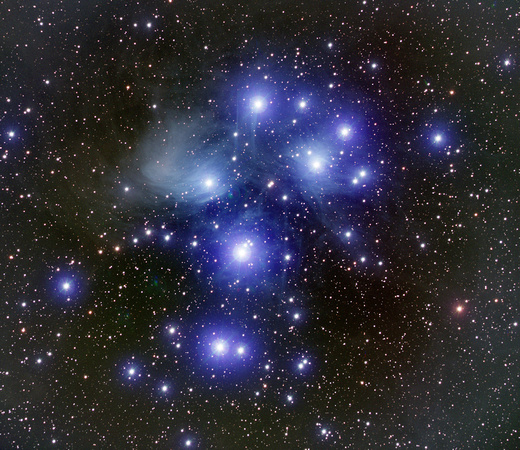M45 aka The Pleiades
I have to say that this one is more spectacular that I thought it would be. I'm really happy with this result. I guess that you could say that it is the quot;first lightquot; complete image that I have taken with my new quot;hyperstarquot; lens. The lens attaches to the front of my 8 inch EdgeHD Celestron, along with the camera, and Makes it a wide field of view f1.9 scope. Without any reducers the scope is a F10. What a fantastically flexible scope this is. At f1.9 I've found that it takes me less than 1/10 of the time to collect images. A shot that took 5 minutes per image with my refactor takes 30 seconds with this one.br/ This object is a star cluster containing over 1000 stars. It's visible with the naked eye. Go out and look at it when you get the chance. I usually notice it as the faint blur of stars, and can just see the blue nebulously. I find it somewhat elusive because you can see more detail with averted vision. You notice it, and then when you look at it, it kind-of disappears. It comes back when you look away. That's just the nature of our vision.br/ It's a reflection nebula. A similar class of object as the Iris nebula, but the dust and gas in this nebula is not the remains of the dust cloud from which it was formed. The cluster, which is around 100 million years old, just happens to be passing through a cloud of dust and is lighting it up. I know know that reflection nebula are generally blue for the same reason that our sky is blue. Look it up!br/ Since it is visible with the unaided human eye, it has a very rich human history. This one is great for a deep dive. It's listed in the Babylonian star catalog, which I never heard about until reading up on the object. There's an awesome object called the quot;Nebra sky diskquot; from 1600 BC which includes it. The Japanese call it Subaru, and the Hawaiians call it Makali'i. Of course the Greeks have put it into all kinds of stories and religion, and of course it was first seen through a telescope by Galileo. For this object there are stories and histories from civilizations across the world and time.br/Imaging telescope / lens:br/ Celestron Cassegrain 203/2032 mm EdgeHD8br/ Starizona Lens 290 mmbr/ Imaging camerabr/ ZWO Optical ASI 1600 MM Pro (CMOS)br/ Mountbr/ Equatorial Losmandy GM811Gbr/ Guiding telescope / lensbr/ Astromania Refractor 60/240 mm Astromania 60br/ Guiding camerabr/ ZWO Optical ASI 178 MC (CMOS)br/ Lights (filter Red)84 x 30 secbr/ Lights (filter Green)54 x 30 secbr/ Lights (filter Blue)33 x 30 secbr/ Total lights integration time 1:25 hours


